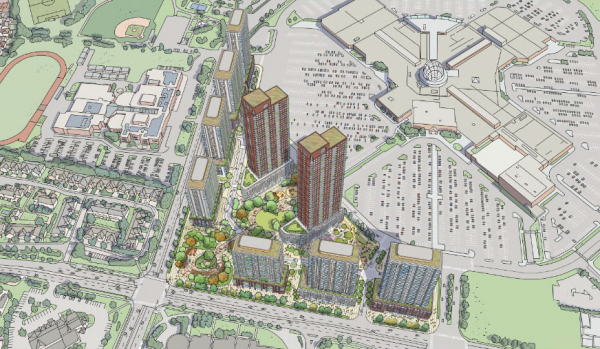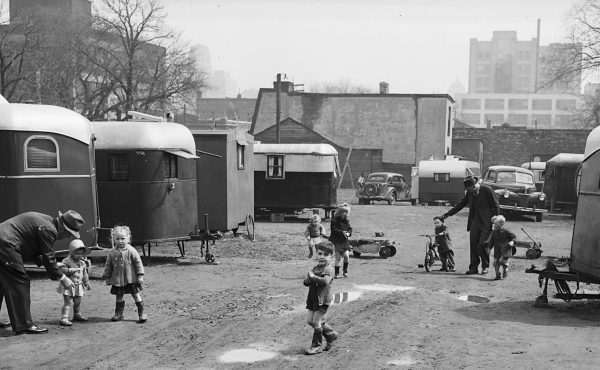As housing shortages continue to pressure municipal officials, cities must place greater priority on effective solutions that have a real chance at market. The agonizing over luxury condos or more “McMansion” style single-family enclaves rings hollow. It is the job of a successful city council to deliver on the needs of residents and not stress over every development proposal. Years into the affordability crisis, we must expect prompt and meaningful action from our city officials.
A project in Mississauga offers a case in point. With the condominium market collapsing, Mississauga is still considering a huge condo development near Erin Mills Town Centre. Planners are studying a proposal by a corporation that owns a local mall, with 61,000 sq.-ft. of commercial space, to add over 3,100 units of precisely the wrong kind of housing. The Erin Mills Town Centre Holdings (EMTC) has proposed nine 20 to 44 storey residential towers to replace the sprawling space surrounding the mall. The affected neighbourhood voiced opposition, mainly citing concerns about overdevelopment and the impact such sudden intensification would have on local infrastructure, the already over-crowded schools, and hospitals in the area.
The Mississauga Planning and Development committee vetting the EMTC proposal has provided confusing signals. The city last year rejected a 42-storey condo within walking distance of the Port Credit GO Station for not fitting the area’s height limits. The city’s rejection received push back from the province for its failure to adhere to the Peel Region plan, which “removes the discretion of lower-tier municipalities to establish maximum heights within major transit station areas.”
While the EMTC development is not situated close to a major regional transit hub, it would become a major disruption to the local MiWay, which relies on a minor terminal within the mall slated for demolition. More importantly, the city’s pivot on inordinately high condo developments suggests a more complacent approach to provincial demands and perhaps developers as well, known to be favourites of Premier Doug Ford. The city had requested the developer to hit a 20% target of affordable units, but EMTC rejected this requirement, dismissing it as “not viable.” In fact, in a report from EMTC Holdings outlining plans and zoning bylaw amendment applications, the corporation states clearly: “the proposal does not contemplate units that are generally affordable to middle income households.” Additionally, rules introduced through Mississauga’s “Reimagining the mall” initiative, which aims to guide healthy growth of mixed use developments, would limit the tallest of the EMTC proposed towers to a height 19 storeys shorter than proposed.
Exploring the controversy, we discover a public that is vocally opposed, height concerns laid by the wayside, affordability labelled as a complete non-starter, all in the name of facilitating more of the same housing that has failed so miserably in Toronto, even as the federal government is considering weighing in to stop the market freefall.
EMTC’s plaza is reportedly underutilized. The lack of productivity from the enormous space does justify redevelopment and underscores the motivation to introduce residential intensification in a growing neighbourhood in place of underutilized commercial space. Ward nine Councillor Martin Reid has even called the development “positive.” While the redevelopment of unproductive commercial space is sensible, it is difficult to discern what is “positive” about 1,761 new single bedroom condo apartments, with the rest being no more than two bedrooms. Condominiums are known to be massively lucrative buildings for developers and property corporations, but what’s in it for the city?
The fact is that we are not in an “underutilized commercial space” crisis but rather a housing crisis. The city might find the addition of 3,146 units of housing very attractive. However, the kind of housing matters. This proposal calls for more unaffordable and unlivable space serving a very small subset of the community. The city should exercise more caution about the allure of large figures or the temporary economic boosts from large construction projects. The development simply does not consider any of the factors that would contribute to solving the housing crisis: EMTC is outspokenly against affordability, the units are not designed as family homes, and the development leaves no room for organic expansion. EMTC’s sky high towers lead nowhere.
The City of Mississauga would much better serve its residents if it encourages and invests in missing middle housing offering affordable, family-oriented solutions which promote organic growth and gentle density. The GTA doesn’t need more luxury towers filled with tiny apartments; it needs more affordability and gentle density. Such goals may only be achieved with the correct municipal policies, especially when Ottawa has signalled reward or punishment depending on housing policy. A wise city council might heed of such signals and amend its zoning bylaws, property setbacks, parking mandates and other archaic rules preventing the development of the kind of housing the GTA needs — the kind of housing EMTC’s proposed development decidedly is not.
Michel Nayrouz holds a master’s degree in environmental science and management and studies the intersection between environmental policy and urban sustainability. Follow him on LinkedIn here.





One comment
This editorial is friendly fire. The kind of midrise housing this editorial likes would go in the residential areas around Erin Mills, not in the Erin Mills parking lot. Blocking a high rise building proposal for having too many undersized studio units will do nothing to help reform zoning that’s blocking redevelopment of lowrise single-family residential into midrise or into lowrise multi-family residential.